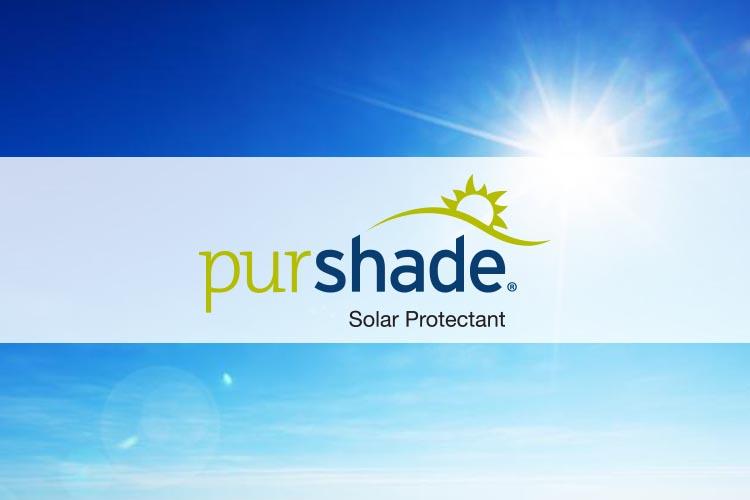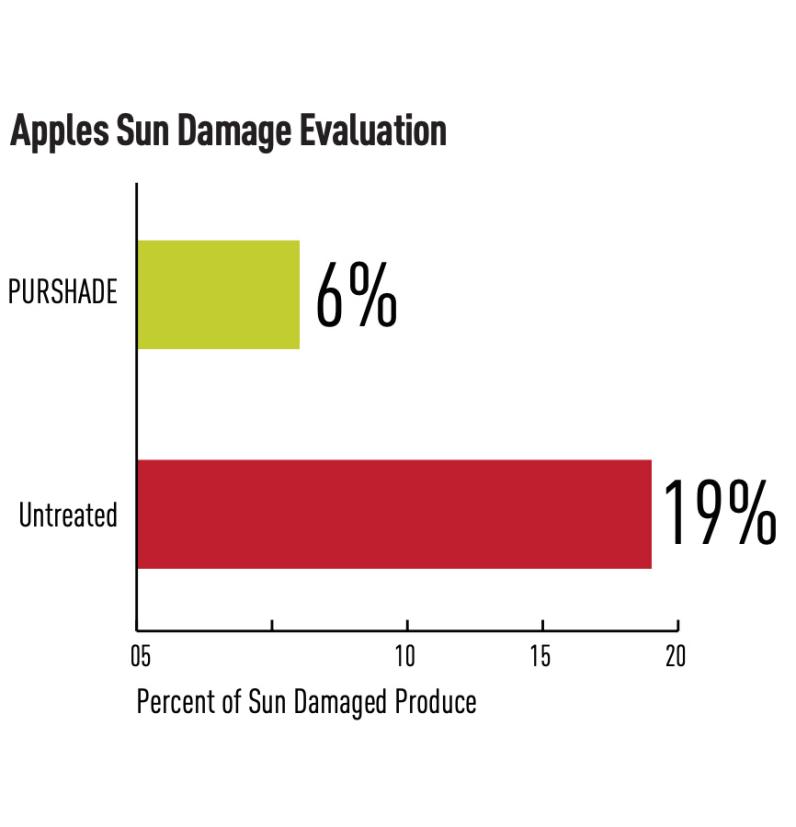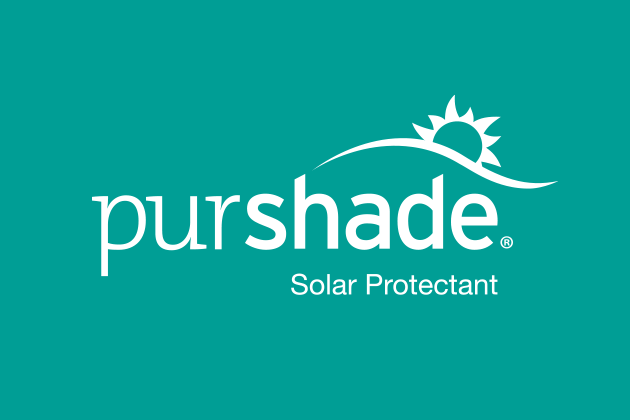Improve Apple Yield and Quality

Reducing Solar Stress on Apples
Sunlight, while essential for the health of apple orchards, can sometimes provide too much of a good thing. Excessive sunlight can burn or discolor fruit, and high temperatures can stress trees, reducing their overall productivity. The losses from sun damage and heat stress can add up quickly and cut deep into a grower’s profit. Fruit temperatures of 114° to 120° F can cause sunburn damage. Applications of Purshade® can lower apple skin temperatures by 10° F or more and tree surface temperatures by 5° to 10° F. In addition, the PURSHADE protective film on plant surfaces increases the deflection of light within the canopy, which improves fruit color.
PURSHADE reduces solar stress in crops by protecting the foliage and fruit from damaging ultraviolet (UV) and infrared (IR) radiation while still allowing photosynthesis to occur. Engineered with advanced reflectance technology and based on calcium carbonate, a highly reflective mineral, PURSHADE has been shown to reduce sunburn damage and minimize overall heat stress. PURSHADE effectively reflects harmful UV and IR radiation away from plants.
Designed with the grower in mind, PURSHADE comes in an easy-to-handle liquid formulation that mixes quickly, applies evenly, is nonabrasive to equipment, and can be removed as required during standard post-harvest processing. The product can be applied with standard spray equipment and in most cases can be incorporated into an existing spray program.* PURSHADE helps maximize the value of every treated acre by reducing solar-related losses, thus increasing marketable yield, enhancing crop quality, and improving water use efficiency.

How Does PURSHADE Work?
PURSHADE plant protectant is available in a flowable suspension concentrate that is mixed with water and then sprayed directly on plant surfaces. Once dry, PURSHADE forms an even film of millions of microscopic “prisms” or mirrors that reflect harmful ultraviolet radiation (UV) and infrared radiation (IR) while not blocking leaf stomata, therefore not impeding photosynthesis. The reflective properties of PURSHADE protect fruit from direct sunburn damage and help prevent heat stress in the entire crop canopy. Keeping plants cooler, while ambient temperatures are extreme, reduces stress and enables the crop to maintain its normal photosynthetic rate longer. When PURSHADE is used during periods of high light and temperature extremes, crops have the solar protection needed to better reach their full potential and use available water resources more efficiently.
Granny Smith apples, Patterson, CA Application dates: 6/4, 7/2, 8/2/2010 @ 101 GPA Sunburn damaged rated on 8/26/2010
-
Benefits
- Improves overall orchard health under high heat stress
- Reduces culls caused by sun damage
- Improves overall pack out
- Improves fruit color
- Enhances water use efficiency
-
Features
- Reduces damage caused by UV and IR radiation
- Easy-to-use, nonabrasive liquid formulation
- Lowers plant surface temperatures, therefore reduces plant stress and promotes biomass development
- Promotes efficient photosynthesis and does not block stomata
- Tank mixes easily*, covers evenly, and can be applied with standard sprayer equipment
- Washes off during standard post-harvest processing
*The compatibility of Purshade with all potential tank mix partners is not knowable. Conduct a jar test first to determine compatibility and consult the product labels of the tank mix partners.
Application Guidelines and Rates
PURSHADE’s liquid formula is designed to mix easily in the tank. The product can be mixed with crop protection products (jar test recommended) and can be applied with typical ground or aerial sprayers using standard nozzles. Standard post-harvest cleaning and washing processes are generally sufficient to remove the PURSHADE product from the surfaces of the fruit.
| APPLICATION GUIDELINES FOR APPLES | ||
| Use | Gallons / Acre | Instructions |
| The first application of PURSHADE should occur prior to fruit size reaching 3/4–1 inch in diameter, or prior to extreme solar conditions. | 3 | Apply before extreme heat conditions occur. |
| Apply PURSHADE 2–3 additional times throughout the season, treating the trees approximately every 14–21 days. | 2 | Apply as needed based on growth and weather conditions. |
| Important: Always read and follow label instructions when using this product. | ||
Use Tips
- Use the amount of water volume per acre needed to achieve uniform spray deposition. Avoid runoff.
- Use fine nozzles and the appropriate tractor speed and pressure to achieve very fine droplets that will not coalesce into larger droplets.
- Apply each application in the opposite direction of the previous application.
- PURSHADE is physically compatible with most crop protection products.
- If compatibility is unknown, perform a jar test before mixing. It is not possible to test every product or combination of products used with PURSHADE. If the effectiveness of a tank mixture is in doubt, apply the materials separately. Do not tank mix with products requiring a neutral or acidic pH, as the alkaline pH of PURSHADE might speed degradation of the other products.
- PURSHADE may be applied in a band spray. Use the recommended rate per acre of PURSHADE in a quantity of water per acre to achieve complete coverage. Adjust the band width and the volume of water based on plant size to achieve uniform coverage.
- Crops that are to be marketed fresh but have a white film of PURSHADE remaining at harvest may be washed. PURSHADE is normally removed with common washing techniques. If the crop is field packed and will not be washed, sprays should be reduced or discontinued in ample time before harvest to allow normal attrition of the film from wind, rain, and plant growth. Consult local experts for more information. Note: When PURSHADE applications are discontinued, the crop will begin to lose its protective coating and sunburn protection will be lost.


